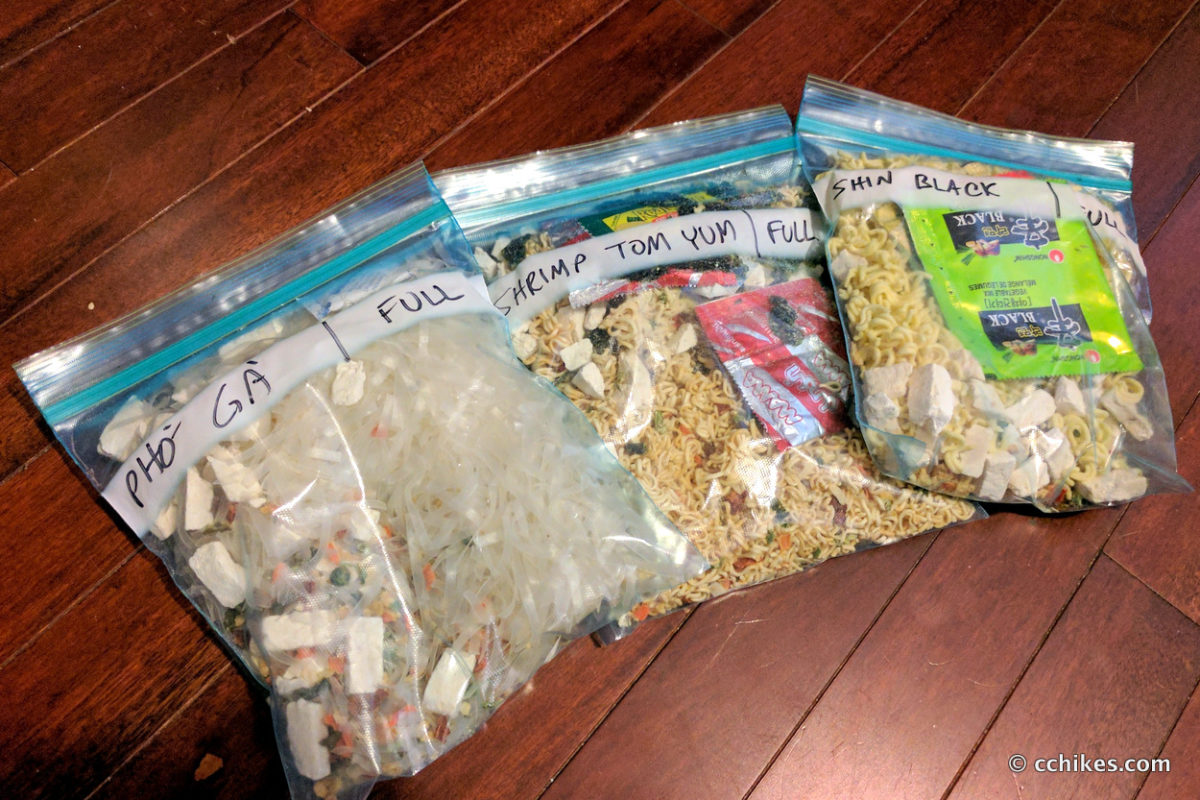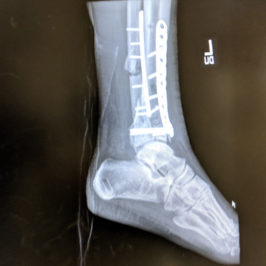Read more about my approach to cooking on backpacking trips, including meal prep, nutrition, gear, and post-hike impressions.
Freezer bag cooking is a method where freeze-dried or dehydrated meals are reconstituted in a zip-top freezer bag. This is the DIY alternative to buying the expensive brands of trail dinners that you find at the big outdoor retailers. The thing is, I love those dinners—especially the offerings from Mountain House and Good To Go.
Those dinners usually run between $9 and $15 for 2-serving packets, which is really just one serving for a backpacker with an appetite. If I’m backpacking for a weekend, I’ll gladly pick up one or two of these for my hot dinners. But for extended hikes, this daily expense is simply not sustainable for most people.
Freezer bag cooking
To save money, many long-distance hikers finish their days with quick-cooking meals like Knorr pasta and rice sides, tortilla wraps, and/or ramen noodles. They divide the contents of their dinners into individual bags when they resupply. Water is brought to a boil at the campsite and then is added to the bag. The bag is sealed and then placed into a cozy to retain its heat while the contents reconstitute.
After stirring to make sure everything has cooked evenly, they put the bag into their pots for stability (or just dig into the bag) and eat with a long-handled spoon. When done, they seal the bag and add it to their trash. This method is safe, easy, and there is no clean-up afterward. It’s important to buy a freezer bag (link below) that will hold up against the heat. And if you buy them in bulk, they’re actually quite cheap.
If you shop through any Amazon link on this website, you support me at no cost to yourself. Learn more in my disclosure.
Better instant noodles
Not all ramen is created equal. Most people think of instant noodles as a 10¢ brick of flavorless noodles and sodium-heavy bouillon. It doesn’t have to be that way. If you visit a proper Asian supermarket, you’ll find scores if not hundreds of different brands and flavors ranging from pennies to around $5 per packet. I’ve listed my favorites below, but a great source for instant ramen information can be found at The Ramen Rater’s website.
You’re unlikely to run across these brands in local stores near the trail, but these are great for shorter trips and for those who plan mail drops on long-distance hikes. If you buy in bulk, you can get these very cheaply. The price won’t compete with the 10¢ packets of Top Ramen, but it pales in comparison to the cost of Mountain House meals. Plus, you can augment the meals to your taste with proteins and vegetables to make them more filling and nutritious.
Adding protein
I love exploring the world of ramen noodles. I own Ivan Orkin’s book on the topic and have cooked the real thing at home. Instant noodles will never compare to the good stuff, but they’re pretty good if you buy the right brands. They’re really good if you dress them up a little.
One of the ways to dress them up is with easy-to-find packets of proteins. Because weight and bulk is an issue, you want to avoid cans. Here is an example, but there are many flavors. I’ll let you explore your local grocery store for different varieties.
SPAM usually costs around $1-2 per packet. This is the cheapest of the non-dried proteins.
Tuna usually costs around $1–3 per packet. Prices are frequently marked down when you buy in bulk (10 for $10 and BOGO deals)
Chicken is more expensive at $4–5 per packet, so I prefer to buy freeze-dried chicken from Mountain House. It is considerably less expensive than wet chicken and tastes really good when hydrated.
A #10 can holds 33 ounces of dried chicken. That means that if you add a half-cup of chicken (which will enlarge when reconstituted), you can augment 27 instant noodle meals with protein. That comes out to an extra $1.67 per meal, which is comparable to the tuna and spam servings per bag.
If you want to try the cooked version, this is what I normally buy. It’s cheaper at the store, so don’t buy it online. It tastes good.
Adding vegetables
One of the biggest challenges on a long-distance hike is working vegetables into meals. Augmenting your freezer bag meals with freeze-dried vegetables dodges many of the pitfalls of hiking with produce. The sampler box below might seem expensive, but these vegetables will be spread over scores of meals. That’s mere change in the cost of vegetables per bag.
This pack features one cup each of broccoli, cabbage, carrots, celery, corn, green beans, jalapenos, leeks, onions, peas, bell peppers, diced potatoes, spinach, and tomatoes. A little goes a long way.
If you just want to experiment with augmenting a few higher-end instant noodle meals, add a few spoonfuls of this vegetable medley to each freezer bag.
Additional ingredients
Other ingredients you can pick up for cheap are dried mushrooms, nori (dried Japanese seaweed), and other ingredients like powdered milk and butter.
You’re essentially using these products to create a customized dinner in a bag. You write what it is and how much water it requires on the bag with a magic marker and then add the ramen and flavorings, the protein, and the extra vegetables.
My favorite instant noodles
Some of these packets are larger than others, so your mileage may vary.
Shin Black is a very spicy, Korean-style ramen (they say ramyun) with thick, springy noodles. It weighs more than most of the other packets on this list, and the price is probably the highest on this list at around $4 per pack. This pairs well with SPAM, mushrooms, cabbage, bell pepper, and sweet corn.
Singapore Curry is a mellow curry with a little spiciness to it. It features thick, chewy noodles. The packets are heavy like Shin Black above, and they are priced accordingly. The oil and coconut flavors balance this dish very nicely. This pairs well with chicken, jalapenos, and leeks.
Tom Yum is spicy Thai-style soup with thin egg noodles. It’s not so different from the flavor of the curry above, but it features more heat. This pairs well with tuna or chicken, spinach, jalapenos, tomatoes, and peppers. You might need to use two packets to make a real dinner portion.
Tonkotsu ramen is a Japanese specialty made from a stock of pork bones. This has a nice, oily pork and sesame taste. SPAM and spicy tuna make great additions, as well as onions, mushrooms, and spinach.
Shio ramen features a light stock made from pork and chicken bones. It has a mild, salty flavor that pairs well with chicken, nori, green onions, and carrots.
Pho Ga is the Vietnamese version of chicken noodle soup with rice noodles. You might need to use two packets to make a real dinner portion, but it’s so cheap that the cost still doesn’t really add up. This pairs well with chicken and pretty much any vegetable that you would normally put in chicken soup—carrots, celery, potatoes, onions, and peas.



















Top 8 Times Ultralight Hikers Repurposed 'Normal' Products - The Hiker Times
[…] These tasty looking meals belong to CCHikes […]